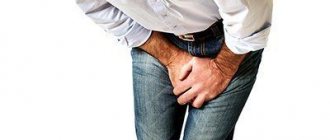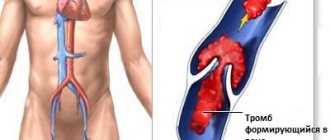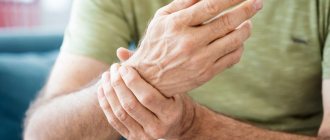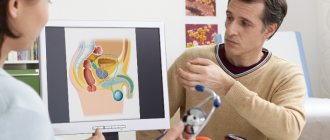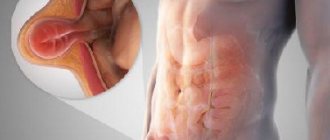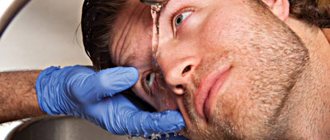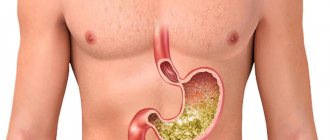The hip joints experience the greatest load in the body. They are created by weight during walking, jumping, running, lifting and carrying heavy objects. Patients often feel pain in the hip joint. Orthopedists at the Yusupov Hospital determine its cause using modern diagnostic equipment. Doctors determine the degree of joint damage, which allows them to make an accurate diagnosis and develop optimal treatment tactics.
Doctors at the Yusupov Hospital provide complex therapy for diseases that cause pain in the hip joint. Patients are individually selected effective medications that affect the cause and mechanism of development of pain. Rehabilitation clinic specialists provide rehabilitation therapy using the latest physiotherapeutic procedures, physical therapy, and acupuncture. The presence of special simulators allows you to reduce the load on the joint during training.
In the process of treating pain in the hip joint, doctors from many areas of medicine are involved: endocrinologists, rheumatologists, orthopedists, physiotherapists, chiropractors, acupuncturists. A multidisciplinary approach to the treatment of pain in the hip joint allows for rapid pain relief. Patients suffering from pathology of the hip joints often require outside care. It is professionally carried out by the staff of the Yusupov Hospital who have undergone special training.
Why does pain occur?
The appearance of pain in the pelvic and groin areas may indicate the development of various pathologies. An experienced doctor can determine what exactly caused such symptoms after conducting a thorough examination.
Such symptoms can manifest themselves against the background of a heart attack in the hip joint, arthrosis of the hip joint, an inflammatory process in the femoral joint, or avascular necrosis.
In the human body, the hip joint (HJ) is the most powerful joint, the task of which is to provide motor activity and also maintain balance. As a result, disturbances in the functioning of this joint cause a decrease in the quality of life.
The articulation includes the acetabulum and the head of the femur, which makes movements inside this cavity. The head is covered with cartilage tissue, which ensures free gliding. There is still a significant part of the femoral neck in the joint cavity.
The most common cause of pain in the pelvic and groin area is joint injury. Not so common are factors of a non-traumatic nature, caused by various pathologies, due to which the joint, cartilage, periarticular tissues are destroyed, and the volume of synovial fluid decreases.
Diseases in different organs and systems can lead to the appearance of such signs. In some cases, pain is associated with inflammation in the area of the pubic, sacroiliac joint, gluteal muscle, and pelvic organs.
In addition, pain can develop against the background of neurological disorders - neuritis in the sciatic nerve, lumbar radiculitis, etc. Sometimes such symptoms are evidence of the development of diseases associated with articular and ligamentous tissue.
The occurrence of pain in the pelvic and groin area is associated with degenerative processes, inflammation, and injuries. Also, the reason may lie in the anatomical features of the articulation, the incorrect location of the femoral head in the acetabulum. The cause of the development of pain can be a dislocation, subluxation of the hip of a traumatic or congenital nature.
Inflammation and infections
Pain in the joint may occur due to infection or inflammation.
Here are the problems that may arise:
- With purulent arthritis, the temperature rises, the joint swells and turns red. Even with light loads, lumbago occurs.
- Tuberculous arthritis occurs with reduced immunity.
- Necrosis of the femoral head is tissue death. There are also sharp pains radiating to the groin area. Analgesics are used to relieve pain symptoms.
- Bursitis is an inflammatory process that is localized in the joint capsule. In this case, a sharp pain is felt along the surface of the leg.
The pain associated with the development of inflammatory processes is nagging and dull in nature. In this case, a burning sensation occurs.
Such pathologies require urgent medical intervention.
Types of pain
Painful manifestations in the pelvis and groin area can vary in severity and course. The pain can be bright and sudden, and sometimes with a long period of growth.
Acute
Usually the pain is short-term, the patient is easily able to determine its location. The appearance of acute pain indicates organic damage or the formation of a disease.
At first, pain occurs in a specific place, and over time it dissipates throughout the body.
Aching
This type of pain usually appears against the background of acute pain manifestations, but covers a larger area.
Painful sensations most often increase and disappear, and after a while they appear again. It is quite difficult to determine the location of pain, which makes therapy difficult.
Chronic
This type of pain can last for more than six months. This symptom is very difficult to identify and treat. Often, to get rid of painful manifestations of a chronic nature, surgery is required.
If pain in the pelvic and groin areas of any nature systematically appears during even minor physical activity, you should immediately consult a doctor. You should not treat yourself, as the disease in its advanced form can cause serious health problems, which will require serious and long-term treatment.
Pathologies of the urinary system
A number of diseases of the urinary system are characterized by chronic pelvic pain
.
| Disease | Clinical manifestations | Diagnostics | Treatment |
| Nephroptosis | Moderate pain that is aching in nature at the initial stage of the disease. As it progresses, it spreads to the abdominal area and intensifies, becomes permanent, and is accompanied by the appearance of blood in the urine. |
|
|
| Chronic cystitis | A symptom of pelvic pain, which is accompanied by the urge to urinate frequently, accompanied by unpleasant sensations and blood in the urine. |
|
|
| Congenital malposition of the kidneys - dystopia |
|
|
|
| Urolithiasis disease |
|
|
|
The main pathologies manifested by pain in the hip joint
Let's look in detail at what diseases such symptoms can develop.
For arthrosis (coxarthrosis) of the hip joint
This disease is diagnosed in every third patient who goes to the doctor with complaints of lumbar pain radiating to the groin area. But, according to qualified doctors, in reality, arthrosis of the hip joint is diagnosed in approximately 30% of patients.
The pathology mostly develops in people over 40 years of age, and women are more susceptible to it. The disease can affect one or both joints at once. Usually, the disease is not detected at an early stage, since the signs are mild and, in some cases, completely absent. Over time, arthrosis progresses. This process can take more than one year, and sometimes rapid progression of the pathology is possible due to injuries, severe stress, and improper movement. In this case, the disease develops to a severe stage in just a couple of months.
With arthrosis of the hip joint, painful manifestations are localized on the thigh on the side and in front, and also radiate to the groin. You can often feel a strong ache in the buttocks with sharp pain radiating to the knee area. At the initial stage, pain appears when a person moves or loads the joint. Over time, such signs can be bothersome even when stationary and during sleep. With arthrosis of the hip joint, a person has difficulty spreading and bending his legs, and it is almost impossible to perform rotational movements of the hip.
A distinctive feature of coxarthrosis is limitations in the motor activity of the affected leg. The patient has difficulty moving, bending and straightening his knee, and moving his leg to the side. Due to lumbar pain, it is impossible to bend over.
For aseptic necrosis
The clinical picture of this pathology resembles the signs of an infarction of the femoral joint. This disease is diagnosed in only 10% of patients who consult a doctor with complaints of pain in the hip and groin area. The symptoms of aseptic necrosis are similar to arthrosis of the hip joint, which makes it difficult for doctors to correctly diagnose the disease.
With aseptic necrosis, a person is already bothered by burning pain in the joints during the first day after the onset of the disease, and the disease reaches its peak after a couple of days. A distinctive feature of this pathology is pain that bothers a person all night and subsides only at dawn. Men under 45 years of age are more susceptible to the disease. In older people, the risk of developing this disease is significantly reduced.
With trochanteritis
Another name for this disease is inflammation of the hip tendons. This is the most common disease that causes pain in the pelvic and groin areas. It is diagnosed in 30% of patients who go to the hospital with similar complaints.
Most often, the disease is diagnosed in women during the postmenopausal period, when muscle and tendon tissue weakens.
The disease can be unilateral or bilateral, development takes from 3 to 14 days. You can determine that the disease has appeared by a sharp, piercing pain localized on the outside of the femoral surface. Inflammation in the tendons leads to acute muscle pain. When moving and sleeping on the side where the damaged area is located, there is pain in the leg and groin area. In comparison with arthrosis of the hip joint, trochanteritis does not shorten the limb, and there is also no pain when abducting the leg to the side. There is no stiffness in movements.
For piriformis syndrome in the lumbar spine
This disease is diagnosed in 30-40% of patients who come to a medical facility with complaints of pain in the lumbar and groin area. The disease can develop on one or both sides, pain symptoms increase over 1-3 days. It can manifest itself regardless of the time of day with the same severity, but often the pain bothers you at night, and it is so intense that a person cannot fall asleep. It is possible that pain may intensify closer to the morning.
Against the background of this pathology, pain in the groin area is not as common as compared to arthrosis of the hip joint. It is usually localized in the lumbar and sacral region, going down the back of the lower limb into the heel. Painful sensations can appear both during the day and at night, usually while walking. Although sometimes pain can wake a person up at night. Mobility in piriformis syndrome is not impaired, but attempting to raise a straight leg can lead to severe pain in the lower back, radiating to the buttock. The reason for the development of the pathology lies in damage to the lumbar region of the spinal column.
Due to unsuccessful movements and heavy lifting, the disease develops faster. The onset of the attack is accompanied by sharp lumbar pain. Pain symptoms often radiate to the buttocks and groin. Sometimes, due to pain, stiffness appears in the space between the groin and knee. A distinctive feature of the disease is the presence of pain in the buttocks, which significantly exceeds the rest.
For polymyalgia rheumatica
This is the rarest disease that causes pain in the groin and hip joint.
This pathology is detected only in 1% of patients who consult a doctor with complaints of lumbar and groin pain. Diagnosed in women over 50 years of age after severe stress or nervous shock.
The disease is characterized by rapid development (from 3 days to 3 weeks). At first, a person is bothered by constant pain in the shoulders and back, but over time it goes down to the gluteal muscles and thigh. The patient suffers from a constant feeling of weakness.
For arthritis
This disease is often diagnosed in older people. The disease is characterized by pain in the hip area, radiating to the lower limb, groin area, often spreading to the front thigh and knee. Painful manifestations increase with movement or attempts to use the injured leg as a support. The patient has difficulty rising from a sitting position.
Severe pain appears in the morning and does not go away after light exercise. Physical activity leads to a significant increase in pain. In addition, movements become constrained, and an attempt to stand up provokes severe pain in the joints.
For bursitis
With this disease, the bursa (a vertical bursa located on top of the protrusion of the hip bone) becomes inflamed. At first, a person is bothered by pain in the gluteal muscles, radiating to the groin area. If you lie on your sore leg, the discomfort increases significantly.
For tendonitis
This pathology is accompanied by damage to the ligamentous tissue of the hip joint, which leads to a significant limitation of motor activity. It becomes difficult to move the leg to the side; due to sharp pain, when trying to make such movements, stiffness appears in the muscles. Walking and leaning on a sore leg is quite difficult.
For infectious arthritis
The cause of the development of this disease is various pathogenic microorganisms (streptococcus, staphylococcus). The disease is characterized by a rapid progression. Within a short time, swelling appears in the joint area, and hyperthermia is observed in combination with fever. Movements become painful, even touching the injured leg brings pain.
If you are concerned about mild pain that does not immediately appear, differential diagnosis is required. This will allow you to distinguish the infectious form of arthritis from tuberculosis, which is accompanied by pain, spreading to the middle thigh or knee joint. Over time, limited movement of the affected joint and swelling appear.
For tumors
Particular attention should be paid to constant aching pain. This is often evidence of the development of a benign or malignant neoplasm. Signs can vary significantly in location and intensity of pain. It is necessary to visit a doctor so that the disease is diagnosed promptly and correctly.
For enthesopathy
With this disease, pain in the groin area is bothersome, radiating to the hip joint. They increase during walking and prolonged standing.
Description and symptoms of pathologies of the articular zone of the musculoskeletal system
Prolonged manifestations of pain are the reason for an MRI of the hip joint. The bone joint itself is not penetrated by nerve fibers, so some diseases can be asymptomatic for a long time. Soreness appears at the stage of damage or compression of the nerve canals passing in the “hinge” region of the body. At the initial stage of the appearance of disorders, unpleasant sensations arise in a limited area of the connection of the femur with the pelvis. If the disease is ignored, the source of inflammation grows and spreads to neighboring tissues: muscle and tendon fibers, cartilage formations, nerve and blood tracts.
A person may experience the following sensations:
- prolonged radiating pain that does not go away within several days, the cause of which can be identified on an MRI of the hip joint;
- night pain leading to insomnia;
- the desire to change positions as often as possible in order to relieve the pelvic joint with constant discomfort in it.
These signs serve as a reason for a thorough diagnosis, and emergency clinical care is required if the patient complains of the following conditions:
- Irradiation to the groin. Through the conductive canal of the nerve, pulsating sensations spread to the lower abdomen and groin area; with inflammation of adjacent fibers, the sciatic nerve is affected.
- Shootings in the lower part of the back. They can be both sharp and dull, pulsating, leading to limited movement of the body and pelvis.
- Spread of pain to the leg, including the knee area. It may manifest itself as muscle weakness or itchy sensations in the skin.
- A “hinge” clutch that prevents free movement of the limb. It is a sign of arthritic and arthrosis lesions.
- Partial or complete lack of mobility associated with the destruction of pelvic tissues or trauma experienced.
- Lameness associated with low intensity pain. It requires correction, since a change in motor habit leads to deformation of the entire musculoskeletal system.
Most patients describe the phenomenon of crunching sounds when changing body position or movement. A kind of crunching sound is produced by individual ligaments. If the sound is not accompanied by unpleasant sensations, there is no need to worry. Additional pain requires contacting a medical specialist.
Other causes of pain
Other diseases can also cause pain in the pelvic and groin areas. When hyperthermia and inflammation appear simultaneously in other joints, rheumatoid arthritis can be diagnosed.
Uncertain pain radiating to the lumbar region, knee, posterior thigh, or gluteal muscle is usually evidence of the development of avascular necrosis of the femoral head, leading over time to its atrophy.
Pain that slowly increases during movement and prolonged standing, accompanied by changes in gait, is often evidence of the formation of osteoarthritis.
Discomfort in the pelvic area occurs in women carrying a child. The reason is changes in hormonal levels, since the unborn baby needs calcium in large quantities.
Joint condition assessment
You can independently navigate and prepare for diagnosis using the following methods:
- Lie down and examine the lower limb; its normal state is parallel to the median axis of the body. The leg is in a forced position when it is fractured or dislocated.
- Determine how intense the pain is in the joint and where it comes from.
- Actively move and rotate the joint, and then evaluate the sensations.
- Notice if there is a clicking or popping sound in the joint during passive movements.
- If you find it very difficult to perform any activity due to pain, you are dealing with a dislocation or fracture.
How is diagnostics carried out?
Hip and groin pain can occur for numerous reasons. Initially, the patient needs examination to establish the correct diagnosis. This directly determines what therapy will be prescribed.
To determine the disease you may need:
- radiography of the hip joint;
- Dopplerography to examine vascular patency;
- CT and MRI;
- electromyography to examine tendon reflexes;
- clinical analysis of urine and blood;
- Ultrasound to determine fluid in the joint cavity;
- osteoscintigraphy to detect bone and joint abnormalities;
- densitometry to determine bone density and strength;
- biochemical, bacteriological and immunological research.
An x-ray of the hip joint is usually sufficient to identify the problem. If necessary, the doctor can prescribe a full diagnosis of the spinal column.
Risk factors and causes of pathologies
We should start with the basics of joint structure. The hip joint is formed by the socket of the pelvic bone and the head of the femur. Cartilaginous tissue completely covers the head of the bone, providing soft gliding. A considerable part of the femoral neck still partially enters the cavity, since it is very deep.
The most obvious characteristic is injury-like damage. The neck is the narrowest part of the thigh and such an injury is very dangerous for the elderly, since bone strength is lost with age.
The most common injury to the hip joint among all possible types of fractures and injuries is a femoral neck fracture.
Other reasons are less obvious, since they provoke pathology only in combination with negative factors. This may be inflammation of the tendons, infectious types of arthritis, osteoarthritis, arthritis. Diseases not only develop, but become more complicated over time if no steps are taken towards treatment.
Degenerative changes in the surfaces of the joints occur, cartilage tissue is damaged, there is a decrease in the amount of fluid in the joints and damage to the structures around the joints.
- Remedies for pain in the hip joint - medicines and traditional medicine recipes
Treatment
Any of the listed diseases that provoke pain in the pelvic and groin area requires complex treatment. In addition, the sore leg needs rest and frequent rest.
Medicines
Usually, to relieve pain in the pelvic area, treatment with anti-inflammatory drugs is indicated - Indomethacin, Diclofenac, Ibuprofen. They can be used in tablet and ointment form.
To relieve muscle spasms, taking muscle relaxants is indicated. In case of severe clinical picture, steroids are prescribed. Diuretics help remove swelling in the tissues. Treatment with glucocorticosteroids (Prednisolone, Methylprednisolone, Dexamethasone) and chondroprotectors (Glucosamine, Chondroitin sulfate) is also indicated.
To activate blood circulation in the leg, Pentoxifylline and Tivortin are prescribed. If the pathology is accompanied by a purulent process, antibiotics are prescribed:
- macrolides (Erythromycin);
- cephalosporins (Cefoperazine, Cefazolin);
- fluoroquinolones (Moxifloxacin).
Massage
To carry out this procedure, you need to contact a specialist once every 6 months. The course of treatment for the causes of hip diseases is 10 sessions.
Physiotherapeutic procedures
Depending on the symptoms of the disease, the following treatment for the hip joint is prescribed:
- electrophoresis with Novocaine to increase the penetration ability of the drug into the damaged area;
- magnetotherapy;
- UHF;
- laser therapy, which has an anti-inflammatory, analgesic and resorption effect.
Exercise therapy
Physical therapy is prescribed after acute symptoms have been relieved and severe pain has been eliminated. The gymnastics is quite simple, it consists of abduction, adduction, flexion and extension of the leg. Initially, the exercises should be performed under medical supervision. It is optimal to perform gymnastics in a pool with warm water.
Operation
If blood or fluid is found in the joint cavity, drainage and rinsing with a special antibacterial solution is recommended.
In a more serious situation, hip replacement is indicated, which consists of replacing the destroyed joint with an artificial analogue. At the end of the surgical intervention and rehabilitation period, physical activity is resumed, which allows the person to return to their normal lifestyle.
Various diseases can provoke pain in the pelvic and groin areas. The main thing is to seek help from a doctor in a timely manner so that he can correctly diagnose and prescribe appropriate treatment.
Treatment of pelvic pain in men
Treatment methods directly depend on the cause that caused them. In any case, it is carried out comprehensively. Thus, for prostate tuberculosis, anti-tuberculosis medications “Salyuzida”, “Metazid” are prescribed, and therapeutic methods are used. If there are indications, they resort to surgery - cavernotomy.
In prostate fibrosis, efforts are directed toward eliminating prostate sclerosis, for which surgical intervention is used to eliminate the affected areas and restore patency of the urinary tract. In addition, treatment of pelvic pain in men
may include physiotherapeutic and local procedures, exercise therapy aimed at stimulating blood flow in the legs. Drinking alcohol, smoking tobacco, and consuming spicy foods is not recommended.
How to get rid of pain?
For the most part, the treatment process is directly dependent on the causes of pain, however, in all pathological conditions, the use of anti-inflammatory drugs (Movalis, Diclofenac Sodium, Ibuprofen, Nimesil) is possible.
The analgesic effect is ensured, and at the same time the level of inflammation decreases. Different pathological conditions are treated in their own way:
- Surgeries are required for malignant process in the hip joint. The tumor must be removed followed by chemotherapy.
- Repositioning of the bone, its realignment and immobilization for months.
- Drainage of the bone cavity and opening are carried out in case of purulent inflammation. This is followed by antibacterial therapy (Cefoperazone, Cefazolin, Ceftriaxone, Erythromycin, Clarithromycin, Levofloxacin, Ciprofloxacin, Moxifloxacin).
- Regeneration drugs that improve blood circulation, for example, Pentoxifylline, restore bone tissue.
- Tivortin is the best medication for normalizing blood flow in the limb; in combination with physiotherapy it gives good results.
The use of all painkillers is completely justified and relevant after surgery, joint replacement or metal osteosynthesis.
Arthritis treatment
Non-steroidal anti-inflammatory drugs are appropriate for severe pain to relieve inflammation and reduce the pain effect:
- Xefocam;
- Nise;
- Ibuprofen;
- Ortofen.
Additionally, antibiotics, drugs to improve immunity, antiallergic drugs, and drugs that improve metabolism are prescribed.
It is forbidden to work on the problem joint; the affected limb must be at rest.
The effectiveness of treatment is predetermined by a correctly identified cause of hip arthritis.
Treatment of coxarthrosis
To treat this pathology, surgery is required, but in the early stages you can start with conservative treatment.
- to eliminate inflammatory processes and relieve pain symptoms, muscle relaxants, steroidal and non-steroidal anti-inflammatory drugs are used;
- plasma lifting should be done to stimulate regenerative processes;
- chondroprotectors and vasodilators to restore cartilage tissue and activate blood supply in the problem area.
Kinesitherapy and physiotherapy are used as additional therapeutic measures. Diet correction is required.
Treatment of bursitis of the trochanteric bursa
Conservative treatment involves the following measures:
- restriction of physical activity;
- local anesthetics in combination with hormonal drugs;
- non-steroidal anti-inflammatory drugs;
- physical therapy, gymnastics, ultrasound and electrophoresis;
Compresses with calendula, sage, pine buds and plantain will not only relieve the inflammatory process, but also prevent the chronic development of pathology. These herbs have anti-edematous and anti-inflammatory effects. In rare cases, doctors resort to surgery if inflammation and pain persist even after long-term conservative treatment. Removing the bursa is the only option, while the hip joint will still function fully.
